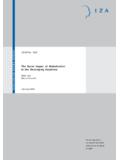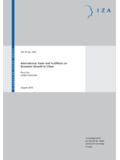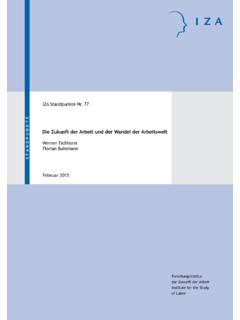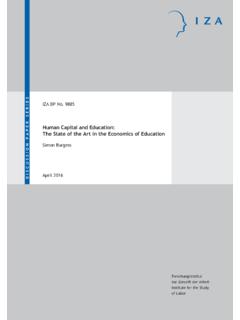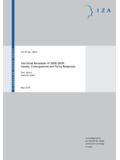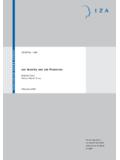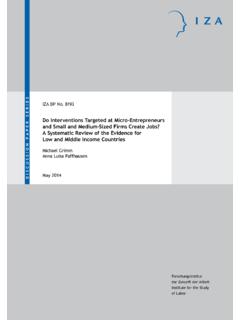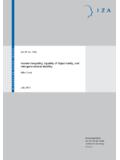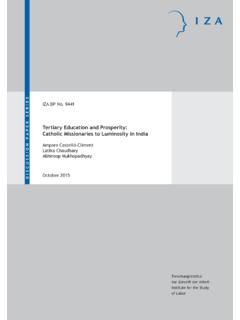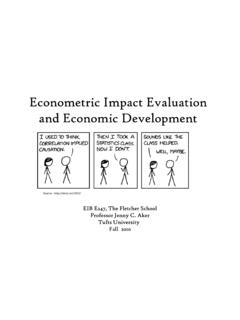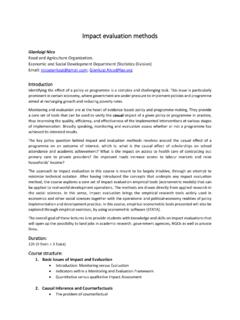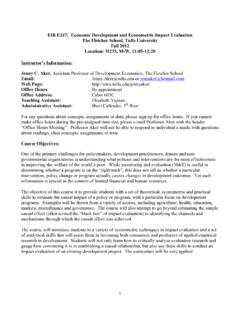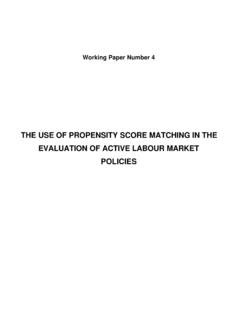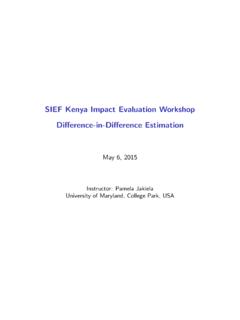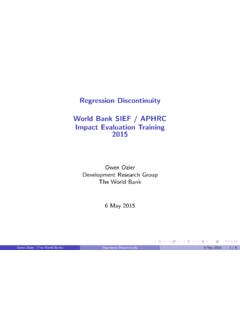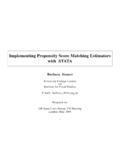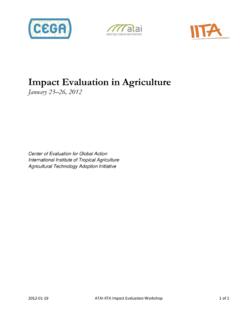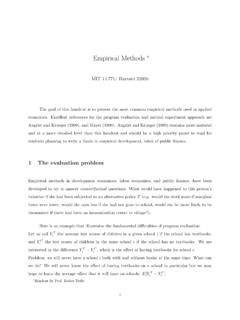Transcription of DISCUSSION PAPER SERIES
1 DISCUSSION PAPER SERIESF orschungsinstitut zur Zukunft der ArbeitInstitute for the Study of Labor The Choice Between Fixed and Random Effects Models: Some Considerations for Educational ResearchIZA DP No. 5287 October 2010 Paul ClarkeClaire CrawfordFiona SteeleAnna Vignoles The Choice Between Fixed and Random Effects Models: Some Considerations for Educational Research Paul Clarke CMPO, University of Bristol Claire Crawford IFS and IoE, University of London Fiona Steele CMM, University of Bristol Anna Vignoles IoE, University of London and IZA DISCUSSION PAPER No. 5287 October 2010 IZA Box 7240 53072 Bonn Germany Phone: +49-228-3894-0 Fax: +49-228-3894-180 E-mail: Any opinions expressed here are those of the author(s) and not those of IZA.
2 Research published in this SERIES may include views on policy, but the institute itself takes no institutional policy positions. The Institute for the Study of Labor (IZA) in Bonn is a local and virtual international research center and a place of communication between science, politics and business. IZA is an independent nonprofit organization supported by Deutsche Post Foundation. The center is associated with the University of Bonn and offers a stimulating research environment through its international network, workshops and conferences, data service, project support, research visits and doctoral program. IZA engages in (i) original and internationally competitive research in all fields of labor economics, (ii) development of policy concepts, and (iii) dissemination of research results and concepts to the interested public.
3 IZA DISCUSSION Papers often represent preliminary work and are circulated to encourage DISCUSSION . Citation of such a PAPER should account for its provisional character. A revised version may be available directly from the author. IZA DISCUSSION PAPER No. 5287 October 2010 ABSTRACT The Choice Between Fixed and Random Effects Models: Some Considerations for Educational Research* We discuss fixed and random effects models in the context of educational research and set out the assumptions behind the two approaches. To illustrate the issues, we analyse the determinants of pupil achievement in primary school, using data from the Avon Longitudinal Study of Parents and Children. We conclude that a fixed effects approach will be preferable in scenarios where the primary interest is in policy-relevant inference of the effects of individual characteristics, but the process through which pupils are selected into schools is poorly understood or the data are too limited to adjust for the effects of selection.
4 In this context, the robustness of the fixed effects approach to the random effects assumption is attractive, and educational researchers should consider using it, even if only to assess the robustness of estimates obtained from random effects models. When the selection mechanism is fairly well understood and the researcher has access to rich data, the random effects model should be preferred because it can produce policy-relevant estimates while allowing a wider range of research questions to be addressed. Moreover, random effects estimators of regression coefficients and shrinkage estimators of school effects are more statistically efficient than those for fixed effects.
5 JEL Classification: C52, I21 Keywords: fixed effects, random effects, multilevel modelling, education, pupil achievement Corresponding author: Anna Vignoles Department of Quantitative Social Science Institute of Education University of London 20 Bedford Way London WC1H 0AL United Kingdom E-mail: * The authors gratefully acknowledge funding from the Economic & Social Research Council (grant number RES-060-23-0011), and would like to thank Rebecca Allen, Simon Burgess and seminar participants at the University of Bristol and the Institute of Education for helpful comments and advice. All errors remain the responsibility of the authors. 2 1. Introduction In this PAPER , we discuss the use of fixed and random effects models in different research contexts.
6 In particular, we set out the assumptions behind the two modelling approaches, highlight their strengths and weaknesses, and discuss how these factors might relate to any particular question being addressed. To illustrate the issues that should be considered when choosing between fixed and random effects models, we analyse the determinants of pupil achievement in primary school, using data from the Avon Longitudinal Study of Parents and Children. Regardless of the research question being addressed, any model of pupil achievement needs to reflect the hierarchical nature of the data structure, where pupils are nested within schools. Estimation of hierarchical regression models in this context can be done by treating school effects as either fixed or random.
7 Currently, the choice of approach seems to be based primarily on the types of research question traditionally studied within each discipline. Economists, for example, are more likely to focus on the impact of personal and family characteristics on achievement (Todd and Wolpin, 2003), and hence tend to use fixed effect In contrast, an important focus for education researchers is on the role of schools (Townsend, 2007), which is best studied using random effects models because fixed effect approaches do not allow school characteristics to be modelled. An important aim of this PAPER is to encourage an inter-disciplinary approach to modelling pupil achievement. In an ideal world, evidence from different disciplines would be brought together to consider the same research question, which in this case is: how can we improve pupil achievement?
8 However, this is only possible if the assumptions underlying the different models used by each discipline are made clear. We hope to contribute to multi-disciplinary understanding and collaboration by highlighting these assumptions and by discussing which approach might be most appropriate in the context of educational research. 3 Economists also tend to use fixed effects models in the context of panel data, where level two corresponds to the individual and level one corresponds to occasion-specific residual error. 3 Another important aim of this PAPER is to highlight that, in the case of economics and education, discipline tradition unnecessarily constrains the types of research question that are addressed.
9 More precisely, we hope to encourage economists that they should not dismiss the random effects approach entirely. In fact, we aim to convince them that, provided they have some understanding of the process through which pupils are selected into schools, and that sufficiently rich data are available to control for the important factors, then the natural approach should be to use random effects because: a) school (level 2) characteristics can be modelled allowing questions concerning differential school effectiveness for different types of pupils using random coefficients to be addressed and b) precision-weighted shrinkage estimates of the school effects can be used. Equally, we hope to make education researchers more aware of the issues concerning causality, the potential robustness of fixed effects, and the need for care when using results from random effects models to inform government policy, particularly where such analyses are based on administrative data sources with a limited range of variables.
10 To illustrate these methodological issues, we consider two topical and important research questions in the field of education. We have chosen these examples to illustrate the selection problems that should influence a researcher s choice of modelling approach. The first example relates to inequality due to the impact of having special educational needs (SEN) on pupil attainment. The second example, continuing with the theme of inequalities in education achievement, is a perennial research question: what impact do children s socio-economic backgrounds, as measured by their eligibility for free school meals (FSM), have on their academic achievement? These examples usefully highlight the importance of choosing the appropriate model for the relevant research question, as we discuss in detail below.
